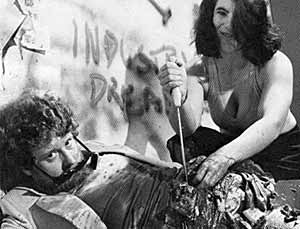FELIX :: Artists - George Kuchar (original) (raw)


Video has many horrors to contend with: just a mention to a film maker that you work in that medium will cause gastric distress to many. I fortunately use that distress in many of my video pieces because to me it is a new and more wholesome form of "splatter movie". But in many cases you just have to blurt out that you work in motion pictures because the pictures do move. Sometimes they move up and down rapidly on the TV monitor and it's called "jitter". To get rid of jitter you have to have several TVs around and then you just try different combinations of each until the image stabilizes. It's expensive but it works so what the hell!
Try to make dubs from your masters at home because in a professional lab the machinery has a hard time with consumer model-made tapes. It's a kind of mechanical snobbery that results in atrocious image definition. Also, the aisles in many of the video labs are too narrow and the technicians bang into the cables, etc., causing massive glitches.
When you tape outdoors or in bright light try to escalate the shutter speed or put on a dense, neutral density filter to cut down the exposure. In video, just as in life, the brighter the light the darker the dark side. Just examine the downfall of Jimmy Swaggart and you'll see that rule in full swing. Little camcorders make big, jumpy shots. When I hold my little, Sony TR-5 close to my chest you can actually get a visual read-out of my heart-beat via horizon-line shudder.
Use the shoulder strap and apply tension and stability by pushing the camcorder away from you and toward your subject. The further the machine gets away from your body the more appealing the result. The tape itself doesn't like to be touched and I guess that goes for the camera too. People say video is very cold and aloof. So video is like a cat and film is more like a dog.
I keep hearing that the image looks better if you shoot under bright lighting conditions but I find the reverse true: low-light sequences appear sharper at times because it looks like you can detect a "grain". So try it out and see which you like better. Human subjects also look better under low-light and bald spots tend to fill in along with the skin pores. I've gotten flattering portraiture results shooting the live subject in a dimly lit room and hitting the face with two flashlight beams. Adjust the flashlights so that shadows are eliminated from the features. Couple this with a diffusion filter and you get very flattering results. You can also use a sheer, black cloth to soften the image, but be careful when you put it on the lens with a rubber band that the excess portion doesn't rub against the microphone and create background sounds that would suggest a potential skin chafing outbreak.
So much for now as I have to go and do errands like mail away cassettes for friends. Please remember to never mail video cassettes off in envelope mailers padded with sofa stuffing. Bubble-wrap shock absorbers are the way to go. Don't wind up like your mother, who bought that big, expensive sofa years ago which has now turned into a series of sandbags that are spilling onto the rug. All that powdered crud will ruin the contents of all it touches, so beware! Someday if mom is in the path of a rampaging creek that sofa may come in handy, but right now it's an eyesore and nasal irritant.
Good luck on your videotaping, and be just as proud of Japan as you were of Switzerland when BOLEX ruled the world.
Best Wishes,
George Kuchar